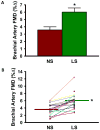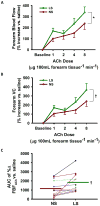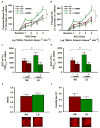Dietary sodium restriction reverses vascular endothelial dysfunction in middle-aged/older adults with moderately elevated systolic blood pressure - PubMed (original) (raw)
Randomized Controlled Trial
. 2013 Jan 22;61(3):335-43.
doi: 10.1016/j.jacc.2012.09.010. Epub 2012 Nov 7.
Affiliations
- PMID: 23141486
- PMCID: PMC3549053
- DOI: 10.1016/j.jacc.2012.09.010
Randomized Controlled Trial
Dietary sodium restriction reverses vascular endothelial dysfunction in middle-aged/older adults with moderately elevated systolic blood pressure
Kristen L Jablonski et al. J Am Coll Cardiol. 2013.
Abstract
Objectives: This study sought to determine the efficacy of dietary sodium restriction (DSR) for improving vascular endothelial dysfunction in middle-aged/older adults with moderately elevated systolic blood pressure (SBP) (130-159 mm Hg) and the associated physiological mechanisms.
Background: Vascular endothelial dysfunction develops with advancing age and elevated SBP, contributing to increased cardiovascular risk. DSR lowers BP, but its effect on vascular endothelial function and mechanisms involved are unknown.
Methods: Seventeen subjects (11 men and 6 women; mean age, 62 ± 7 years) completed a, randomized crossover study of 4 weeks of both low (DSR) and normal sodium intake. Vascular endothelial function (endothelium-dependent dilation; EDD), nitric oxide (NO)/tetrahydrobiopterin (BH(4)) bioavailability, and oxidative stress-associated mechanisms were assessed following each condition.
Results: Urinary sodium excretion was reduced by ≈ 50% (to 70 ± 30 mmol/day), and conduit (brachial artery flow-mediated dilation [FMD(BA)]) and resistance (forearm blood flow responses to acetylcholine [FBF(ACh)]) artery EDD were 68% and 42% (peak FBF(ACh)) higher following DSR (p < 0.005). Low sodium markedly enhanced NO-mediated EDD (greater ΔFBF(ACh) with endothelial NO synthase inhibition) without changing endothelial NO synthase expression/activation (Ser 1177 phosphorylation), restored BH(4) bioactivity (less ΔFMD(BA) with acute BH(4)), abolished tonic superoxide suppression of EDD (less ΔFMD(BA) and ΔFBF(ACh) with ascorbic acid infusion), and increased circulating superoxide dismutase activity (all p < 0.05). These effects were independent of ΔSBP. Other subject characteristics/dietary factors and endothelium-independent dilation were unchanged.
Conclusions: DSR largely reversed both macro- and microvascular endothelial dysfunction by enhancing NO and BH(4) bioavailability and reducing oxidative stress. Our findings support the emerging concept that DSR induces "vascular protection" beyond that attributable to its BP-lowering effects.
Copyright © 2013 American College of Cardiology Foundation. Published by Elsevier Inc. All rights reserved.
Figures
Figure 1. 24-hour Urinary Sodium and Potassium Excretion
24-hour urinary excretion of sodium (left) and potassium (right) at baseline (B), weeks 1–5 of the normal sodium condition (N1–N5) and weeks 1–5 of the low sodium condition (L1–L5). Values are mean ± S.E.; * P<0.001; † P<0.005 vs. baseline or normal sodium of same week (repeated measures ANOVA with post-hoc Bonferonni corrected comparisons; n=17).
Figure 2. Brachial Artery Flow-Mediated Dilation
Mean group (A) and individual subject (B) brachial artery FMD %Δ during normal sodium [NS] vs. low sodium [LS] condition. Values are mean ± S.E.; *P<0.001 vs. NS (linear mixed-effects models (see supplement for details); n=16/17). Note, all seventeen subjects are shown in (B), but due to similarities some subjects overlap and may not be individually distinguishable.
Figure 3. Forearm Blood Flow to Acetylcholine
Forearm blood flow [FBF] (A) and vascular conductance [VC] (B) response to acetylcholine [ACh] during normal sodium [NS] vs. low sodium [LS]. Individual subject FBFAch (area under the curve, AUC) (C). Values are mean ± S.E.; * P<0.005; † p<0.05 LS vs. NS (linear mixed-effects model; n=12/13).
Figure 4. Contribution of eNOS to EDD
Dose-response for forearm blood flow [FBF] (A) and forearm vascular conductance [FVC] (B) to acetylcholine [ACh] + _N_G monomethyl-L-arginine [L-NMMA] during normal sodium [NS] and low sodium [LS]; area under the curve [AUC] values (C–D). Total endothelial nitric oxide synthase [eNOS] protein (E) and eNOS phosphorylated at Ser 1177 [PeNOS] (F) in subjects’ endothelial cells relative to human umbilical vein endothelial cell [HUVEC] control; representative images shown below. Values are mean ± S.E.; * P<0.001; † P<0.05 (drug x sodium condition interaction; linear mixed-effects model; n=12/13).
Figure 5. Contributions of Oxidative Stress and BH4 Bioavailability to EDD
Brachial artery FMD %Δ during normal sodium [NS] vs. low sodium [LS] ± co-administration of ascorbic acid [Vit C] and/or tetrahydrobiopterin [BH4] (A). Circulating superoxide dismutase [SOD] activity (B). Forearm blood flow (C) and vascular conductance (D) response to acetylcholine [ACh] ± Vit C. Values are mean ± S.E.; * p<0.001; † p<0.005; ‡ p<0.05 (drug x sodium condition interaction or main effect of sodium condition; linear mixed-effects model; n=12–17).
Comment in
- Excessive sodium intake and cardiovascular disease: a-salting our vessels.
Celermajer DS, Neal B. Celermajer DS, et al. J Am Coll Cardiol. 2013 Jan 22;61(3):344-5. doi: 10.1016/j.jacc.2012.08.998. Epub 2012 Nov 7. J Am Coll Cardiol. 2013. PMID: 23141488 No abstract available.
Similar articles
- Effect of dietary sodium restriction on human urinary metabolomic profiles.
Jablonski KL, Klawitter J, Chonchol M, Bassett CJ, Racine ML, Seals DR. Jablonski KL, et al. Clin J Am Soc Nephrol. 2015 Jul 7;10(7):1227-34. doi: 10.2215/CJN.11531114. Epub 2015 Apr 21. Clin J Am Soc Nephrol. 2015. PMID: 25901092 Free PMC article. Clinical Trial. - Low dietary sodium intake is associated with enhanced vascular endothelial function in middle-aged and older adults with elevated systolic blood pressure.
Jablonski KL, Gates PE, Pierce GL, Seals DR. Jablonski KL, et al. Ther Adv Cardiovasc Dis. 2009 Oct;3(5):347-56. doi: 10.1177/1753944709345790. Epub 2009 Sep 1. Ther Adv Cardiovasc Dis. 2009. PMID: 19723834 Free PMC article. - Cytochrome P-450 2C9 signaling does not contribute to age-associated vascular endothelial dysfunction in humans.
Donato AJ, Eskurza I, Jablonski KL, Gano LB, Pierce GL, Seals DR. Donato AJ, et al. J Appl Physiol (1985). 2008 Oct;105(4):1359-63. doi: 10.1152/japplphysiol.90629.2008. Epub 2008 Jul 31. J Appl Physiol (1985). 2008. PMID: 18669935 Free PMC article. - Nitric oxide in hypertension.
Hermann M, Flammer A, Lüscher TF. Hermann M, et al. J Clin Hypertens (Greenwich). 2006 Dec;8(12 Suppl 4):17-29. doi: 10.1111/j.1524-6175.2006.06032.x. J Clin Hypertens (Greenwich). 2006. PMID: 17170603 Free PMC article. Review.
Cited by
- Dietary nitrate is a modifier of vascular gene expression in old male mice.
Rammos C, Totzeck M, Deenen R, Köhrer K, Kelm M, Rassaf T, Hendgen-Cotta UB. Rammos C, et al. Oxid Med Cell Longev. 2015;2015:658264. doi: 10.1155/2015/658264. Epub 2015 Mar 8. Oxid Med Cell Longev. 2015. PMID: 25838870 Free PMC article. - Oxidative Stress Induced by High Salt Diet-Possible Implications for Development and Clinical Manifestation of Cutaneous Inflammation and Endothelial Dysfunction in Psoriasis vulgaris.
Krajina I, Stupin A, Šola M, Mihalj M. Krajina I, et al. Antioxidants (Basel). 2022 Jun 27;11(7):1269. doi: 10.3390/antiox11071269. Antioxidants (Basel). 2022. PMID: 35883760 Free PMC article. Review. - Low-sodium DASH diet improves diastolic function and ventricular-arterial coupling in hypertensive heart failure with preserved ejection fraction.
Hummel SL, Seymour EM, Brook RD, Sheth SS, Ghosh E, Zhu S, Weder AB, Kovács SJ, Kolias TJ. Hummel SL, et al. Circ Heart Fail. 2013 Nov;6(6):1165-71. doi: 10.1161/CIRCHEARTFAILURE.113.000481. Epub 2013 Aug 28. Circ Heart Fail. 2013. PMID: 23985432 Free PMC article. Clinical Trial. - Apocynin and Tempol ameliorate dietary sodium-induced declines in cutaneous microvascular function in salt-resistant humans.
Ramick MG, Brian MS, Matthews EL, Patik JC, Seals DR, Lennon SL, Farquhar WB, Edwards DG. Ramick MG, et al. Am J Physiol Heart Circ Physiol. 2019 Jul 1;317(1):H97-H103. doi: 10.1152/ajpheart.00786.2018. Epub 2019 May 10. Am J Physiol Heart Circ Physiol. 2019. PMID: 31074652 Free PMC article. Clinical Trial. - Pathophysiology and genetics of salt-sensitive hypertension.
Maaliki D, Itani MM, Itani HA. Maaliki D, et al. Front Physiol. 2022 Sep 13;13:1001434. doi: 10.3389/fphys.2022.1001434. eCollection 2022. Front Physiol. 2022. PMID: 36176775 Free PMC article. Review.
References
- Yeboah J, Crouse JR, Hsu FC, Burke GL, Herrington DM. Brachial flow-mediated dilation predicts incident cardiovascular events in older adults: The Cardiovascular Health Study. Circulation. 2007;115:2390–7. - PubMed
- Heitzer T, Schlinzig T, Krohn K, Meinertz T, Munzel T. Endothelial dysfunction, oxidative stress, and risk of cardiovascular events in patients with coronary artery disease. Circulation. 2001;104:2673–8. - PubMed
- Celermajer DS, Sorensen KE, Spiegelhalter DJ, Georgakopoulos D, Robinson J, Deanfield JE. Aging is associated with endothelial dysfunction in healthy men years before the age-related decline in women. J Am Coll Cardiol. 1994;24:471–6. - PubMed
Publication types
MeSH terms
Substances
Grants and funding
- AG03114/AG/NIA NIH HHS/United States
- UL1 TR000154/TR/NCATS NIH HHS/United States
- AG03167/AG/NIA NIH HHS/United States
- R01 AG013038/AG/NIA NIH HHS/United States
- AG033994/AG/NIA NIH HHS/United States
- R37 AG013038/AG/NIA NIH HHS/United States
- P30 DK048520/DK/NIDDK NIH HHS/United States
- AG006537/AG/NIA NIH HHS/United States
- F31 AG033994/AG/NIA NIH HHS/United States
- AG013038/AG/NIA NIH HHS/United States
- TR000154/TR/NCATS NIH HHS/United States
- R01 AG031141/AG/NIA NIH HHS/United States
- R01 AG006537/AG/NIA NIH HHS/United States
- UL1 TR001082/TR/NCATS NIH HHS/United States
LinkOut - more resources
Full Text Sources
Other Literature Sources
Medical




